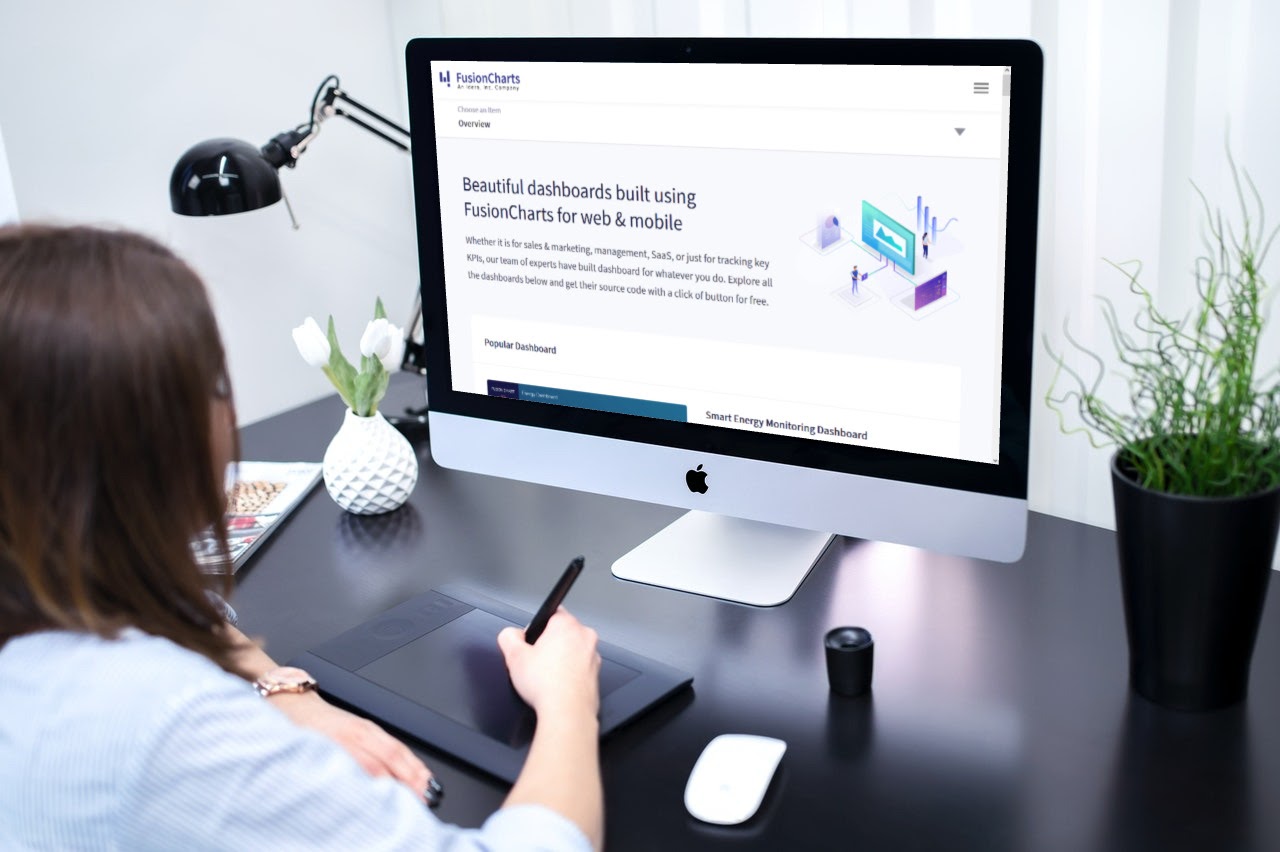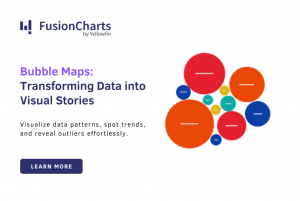Professionals in every field are expected to have certain fundamental skillsets. These include interpersonal and time management skills as well as communication abilities. There is, however, another skill set that is becoming increasingly valuable. As our world becomes more reliant on harnessing data, and data becomes more accessible, data literacy is in high demand. More specifically, professionals in every sector are going to have become skillful at effective data communication, analysis and manipulation.
Simply put, having the right data skills will stand out on your CV. These marketable skills include reviewing data, validating its quality, and gathering insights from it. You will also need to be proficient at communicating the findings you have gathered. For this critical task, you need to be good at data visualization.
Data visualization is one of the most exciting aspects of working with data because it involves both intuition and skill. Best of all, by mastering some basic principles, you can learn to efficiently communicate your data insights. Most people start with mastering the most basic form of data visualization — data charts. As you get more familiar with charts, tools like FusionCharts will provide beautiful visualizations that you can use to communicate your findings.
This article goes through why you should understand your data and master charting. Let’s look at the step-by-step process to charting mastery.
 If you said that many enterprises drive their growth with data, then you’d be right. Many enterprises depend on data from various sources to design better products, make better investments, and fine-tune their path towards profitability. But this isn’t a trend limited just to enterprises. Researchers, government institutions, and scientists also use and learn from data to efficiently achieve their goals.
We are basically living during the data revolution. It only makes sense to develop the skills to participate. It is important to remember, however, that you need both data wrangling and storytelling abilities. After gathering insights from rows and columns of data, you have to paint a picture that others understand. That is where charts come into play.
Charts are an essential tool in your data visualization and communication toolbox. You can employ charts to help you concisely present your hard-won insights. Charts are also intuitive and visually appealing. The innate intuitiveness of images helps even the most non-technical individuals understand the data trends you have uncovered.
If you said that many enterprises drive their growth with data, then you’d be right. Many enterprises depend on data from various sources to design better products, make better investments, and fine-tune their path towards profitability. But this isn’t a trend limited just to enterprises. Researchers, government institutions, and scientists also use and learn from data to efficiently achieve their goals.
We are basically living during the data revolution. It only makes sense to develop the skills to participate. It is important to remember, however, that you need both data wrangling and storytelling abilities. After gathering insights from rows and columns of data, you have to paint a picture that others understand. That is where charts come into play.
Charts are an essential tool in your data visualization and communication toolbox. You can employ charts to help you concisely present your hard-won insights. Charts are also intuitive and visually appealing. The innate intuitiveness of images helps even the most non-technical individuals understand the data trends you have uncovered.
 Charts are pretty easy to work with but aren’t entirely foolproof. They are especially prone to your bad creative decisions. There are multiple aspects of chart design you need to take into account depending on your audience and the data you are presenting. For example, a younger audience will require a more vibrant visual to focus them on what your chart is communicating. A more mature audience, on the other hand, appreciates clarity and straightforward chart design.
There is also the challenge of going through the enormous variety of chart options available to you. Some charts won’t make sense for specific datasets. Conversely, you may find yourself spoiled for choice with many charts to choose from. What you choose depends on your experience and the insights you are trying to communicate. There are no hard-and-fast rules, ultimately you decide.
Finally, charts aren’t limited to the two-dimensional visuals you see in presentations and reports. You may need to put your charts and visualizations on a website or blog for everyone to see. Web charts are more successful if they are interactive and the user can manipulate them to their own ends. Tools like FusionCharts are beneficial when you are building interactive and appealing charts.
Charts are pretty easy to work with but aren’t entirely foolproof. They are especially prone to your bad creative decisions. There are multiple aspects of chart design you need to take into account depending on your audience and the data you are presenting. For example, a younger audience will require a more vibrant visual to focus them on what your chart is communicating. A more mature audience, on the other hand, appreciates clarity and straightforward chart design.
There is also the challenge of going through the enormous variety of chart options available to you. Some charts won’t make sense for specific datasets. Conversely, you may find yourself spoiled for choice with many charts to choose from. What you choose depends on your experience and the insights you are trying to communicate. There are no hard-and-fast rules, ultimately you decide.
Finally, charts aren’t limited to the two-dimensional visuals you see in presentations and reports. You may need to put your charts and visualizations on a website or blog for everyone to see. Web charts are more successful if they are interactive and the user can manipulate them to their own ends. Tools like FusionCharts are beneficial when you are building interactive and appealing charts.
 Once you have decided to dedicate time and effort to become better at charting and data visualization through charts, you need a roadmap. There are many resources available out there to help you with your journey, but it can get overwhelming. Let’s break the process into steps and milestones to help you become better at charts quickly.
Here is what you need to do to master making and using charts:
Once you have decided to dedicate time and effort to become better at charting and data visualization through charts, you need a roadmap. There are many resources available out there to help you with your journey, but it can get overwhelming. Let’s break the process into steps and milestones to help you become better at charts quickly.
Here is what you need to do to master making and using charts:
 Mastering charts takes time, practice, and consistent interaction with enormous amounts of data. However, choosing the right tools to accompany and support your journey towards becoming a chart master makes it much more manageable. FusionCharts provides you with an expansive assortment of charts and visualizations. In addition, you can build individual charts or a dedicated dashboard of multiple different ones.
Charts made with FusionCharts are interactive and easily integrated into your website’s front-end. It has multiple themes you can use and its easy syntax gets you going quickly. If you need help at any point, there is a dedicated support system to guide you.
Feel like mastering the charts with a handy and intuitive visualization tool by your side? Go to FusionCharts and explore what charts can do for you.
Mastering charts takes time, practice, and consistent interaction with enormous amounts of data. However, choosing the right tools to accompany and support your journey towards becoming a chart master makes it much more manageable. FusionCharts provides you with an expansive assortment of charts and visualizations. In addition, you can build individual charts or a dedicated dashboard of multiple different ones.
Charts made with FusionCharts are interactive and easily integrated into your website’s front-end. It has multiple themes you can use and its easy syntax gets you going quickly. If you need help at any point, there is a dedicated support system to guide you.
Feel like mastering the charts with a handy and intuitive visualization tool by your side? Go to FusionCharts and explore what charts can do for you.
Table of Contents
Are Charts Even That Important For You?
 If you said that many enterprises drive their growth with data, then you’d be right. Many enterprises depend on data from various sources to design better products, make better investments, and fine-tune their path towards profitability. But this isn’t a trend limited just to enterprises. Researchers, government institutions, and scientists also use and learn from data to efficiently achieve their goals.
We are basically living during the data revolution. It only makes sense to develop the skills to participate. It is important to remember, however, that you need both data wrangling and storytelling abilities. After gathering insights from rows and columns of data, you have to paint a picture that others understand. That is where charts come into play.
Charts are an essential tool in your data visualization and communication toolbox. You can employ charts to help you concisely present your hard-won insights. Charts are also intuitive and visually appealing. The innate intuitiveness of images helps even the most non-technical individuals understand the data trends you have uncovered.
If you said that many enterprises drive their growth with data, then you’d be right. Many enterprises depend on data from various sources to design better products, make better investments, and fine-tune their path towards profitability. But this isn’t a trend limited just to enterprises. Researchers, government institutions, and scientists also use and learn from data to efficiently achieve their goals.
We are basically living during the data revolution. It only makes sense to develop the skills to participate. It is important to remember, however, that you need both data wrangling and storytelling abilities. After gathering insights from rows and columns of data, you have to paint a picture that others understand. That is where charts come into play.
Charts are an essential tool in your data visualization and communication toolbox. You can employ charts to help you concisely present your hard-won insights. Charts are also intuitive and visually appealing. The innate intuitiveness of images helps even the most non-technical individuals understand the data trends you have uncovered.
What Should You Keep In Mind To Make The Best Charts?
 Charts are pretty easy to work with but aren’t entirely foolproof. They are especially prone to your bad creative decisions. There are multiple aspects of chart design you need to take into account depending on your audience and the data you are presenting. For example, a younger audience will require a more vibrant visual to focus them on what your chart is communicating. A more mature audience, on the other hand, appreciates clarity and straightforward chart design.
There is also the challenge of going through the enormous variety of chart options available to you. Some charts won’t make sense for specific datasets. Conversely, you may find yourself spoiled for choice with many charts to choose from. What you choose depends on your experience and the insights you are trying to communicate. There are no hard-and-fast rules, ultimately you decide.
Finally, charts aren’t limited to the two-dimensional visuals you see in presentations and reports. You may need to put your charts and visualizations on a website or blog for everyone to see. Web charts are more successful if they are interactive and the user can manipulate them to their own ends. Tools like FusionCharts are beneficial when you are building interactive and appealing charts.
Charts are pretty easy to work with but aren’t entirely foolproof. They are especially prone to your bad creative decisions. There are multiple aspects of chart design you need to take into account depending on your audience and the data you are presenting. For example, a younger audience will require a more vibrant visual to focus them on what your chart is communicating. A more mature audience, on the other hand, appreciates clarity and straightforward chart design.
There is also the challenge of going through the enormous variety of chart options available to you. Some charts won’t make sense for specific datasets. Conversely, you may find yourself spoiled for choice with many charts to choose from. What you choose depends on your experience and the insights you are trying to communicate. There are no hard-and-fast rules, ultimately you decide.
Finally, charts aren’t limited to the two-dimensional visuals you see in presentations and reports. You may need to put your charts and visualizations on a website or blog for everyone to see. Web charts are more successful if they are interactive and the user can manipulate them to their own ends. Tools like FusionCharts are beneficial when you are building interactive and appealing charts.
What are the Six Main Steps to Mastering Charts?
 Once you have decided to dedicate time and effort to become better at charting and data visualization through charts, you need a roadmap. There are many resources available out there to help you with your journey, but it can get overwhelming. Let’s break the process into steps and milestones to help you become better at charts quickly.
Here is what you need to do to master making and using charts:
Once you have decided to dedicate time and effort to become better at charting and data visualization through charts, you need a roadmap. There are many resources available out there to help you with your journey, but it can get overwhelming. Let’s break the process into steps and milestones to help you become better at charts quickly.
Here is what you need to do to master making and using charts:
Develop A Good Sense Of Your Data And Its Insights
Charts communicate what your data is telling you. Before you start to visualize it with charts, define the explicit purpose of the visualization. For example, you may need to prove an argument you are presenting or visualize an insight you found.Develop A Keen Knowledge About Different Kinds Of Charts
Charts are one of the oldest forms of data visualization. Because of this, there are many many different kinds of charts. Each suits a certain type of data. When you are confronted with multiple choices, decide which factors you want to emphasize, like audience type or data complexity.Learn What Kind Of Charts Best Explain Which Kind Of Insights
Some charts will confuse your audience if they don’t present the data or your insights properly. Knowing the different charts types is essential, but chart relevance is also vital.Learn To Declutter Your Charts
Charts can show multiple aspects of your data and insights. You need to learn which elements are helpful and which are a hindrance. You don’t users to get miss the point because your chart is cluttered.Know how to Direct your Audience’s Attention
Sometimes, a chart may lack the emphasis you need. When this happens, you need to know when to add additional details. Adding text and images can clarify a chart’s purpose. Go lightly, many charts simply don’t need help and all you are really adding is clutter.Practice With Different Scenarios And Types Of Data
Finally, practice makes perfect. Keep looking for different data sets and think about how you would visualize them. A lot of mastery comes with experience, so practice, practice, practice.How Can FusionCharts Help You Become a Chart Master?
 Mastering charts takes time, practice, and consistent interaction with enormous amounts of data. However, choosing the right tools to accompany and support your journey towards becoming a chart master makes it much more manageable. FusionCharts provides you with an expansive assortment of charts and visualizations. In addition, you can build individual charts or a dedicated dashboard of multiple different ones.
Charts made with FusionCharts are interactive and easily integrated into your website’s front-end. It has multiple themes you can use and its easy syntax gets you going quickly. If you need help at any point, there is a dedicated support system to guide you.
Feel like mastering the charts with a handy and intuitive visualization tool by your side? Go to FusionCharts and explore what charts can do for you.
Mastering charts takes time, practice, and consistent interaction with enormous amounts of data. However, choosing the right tools to accompany and support your journey towards becoming a chart master makes it much more manageable. FusionCharts provides you with an expansive assortment of charts and visualizations. In addition, you can build individual charts or a dedicated dashboard of multiple different ones.
Charts made with FusionCharts are interactive and easily integrated into your website’s front-end. It has multiple themes you can use and its easy syntax gets you going quickly. If you need help at any point, there is a dedicated support system to guide you.
Feel like mastering the charts with a handy and intuitive visualization tool by your side? Go to FusionCharts and explore what charts can do for you.



